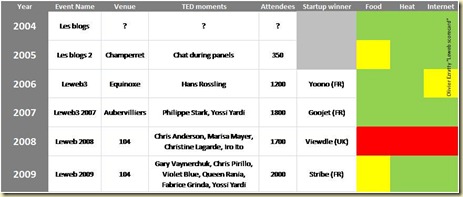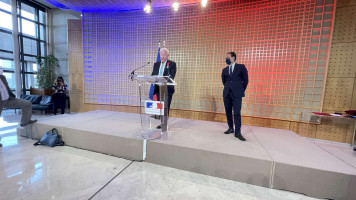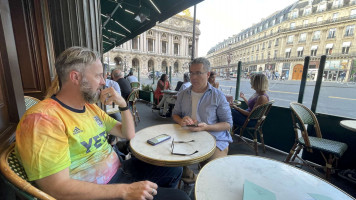It’s been a couple days now since Leweb 2009 ended. And I’m quite far from the “Real time web” with that report of the event, which as usual, will be split in a several posts.
This year’s edition was definitively a hit. The most important success factors of such an event are: do we enjoy these so-called “TED moments”, when speakers build an emotional connection with the audience, then, do we meet the right people there and at last, are the logistics doing well.
In the Leweb historical scorecard that I assembled below, it looks like the mix of this year’s edition has been the best so far. I just missed the first “Les blogs” in this series of events but it was rather small with only a few hundred attendees. And I don’t necessary recollect well the best “TED moments” from the 2007 and before editions. The number of attendees is an estimate. If it’s wrong, I will correct it.
We can all thank Loic and Géraldine Lemeur to have created over the last six years the best franchise for a web dedicated event based in Europe. It’s both a place whe re american leaders of the industry meet and talk, and one where European entrepreneurs can learn from them, network and also showcase their own companies. This is the contradiction from Loic Lemeur: established in the Silicon Valley for pragmatic reasons, but still willing to help those startups who stay in Europe and want their tickets to broader worldwide markets.
re american leaders of the industry meet and talk, and one where European entrepreneurs can learn from them, network and also showcase their own companies. This is the contradiction from Loic Lemeur: established in the Silicon Valley for pragmatic reasons, but still willing to help those startups who stay in Europe and want their tickets to broader worldwide markets.
Besides the above criterias, there were other nice things with Leweb this year:
- Students could register for 150€ and they did show up! Loic asked how many students where present in the main sessions and roughly 5%-10% of the hands raised.
- The live and offlline video stream from UStream went perfectly and was watched by 10s of thousands of viewers. And the startup competition presentations were even available, making it an even better marketing investment for the participating companies. Marco Montemagno from Italy did attend Leweb remotely and offers some interesting suggestions to further improve the conference, particularly for those who watch it online.
- The top management from the leading US web leaders where all there: Twitter, Facebook, Google, MySpace, Paypal, Microsoft.
Areas for improvement still exist, such as:
- The sponsors visibility on stage was probably inflated, as we’ll see in my detailed report. It was even not clear for some companies whether they “bought” their ticket on stage or were there just on their merit. The large poster in the picture below shows the sheer number of sponsors! You still need them to fund the event. Sponsors should really work better their main session appearances.
- It even looked like when you’re a very close friend of Loic Lemeur, whatever business you’re in, you’ll get your slot on stage in the agenda. Ouriel Oyahon and
 Tariq Krim were such examples. Some speakers are also showing up repeatedly at Leweb like Robert Scoble, Mike Arrington, Martin Varzavsky, Marc Simoncini. Maybe is it time for some shift here.
Tariq Krim were such examples. Some speakers are also showing up repeatedly at Leweb like Robert Scoble, Mike Arrington, Martin Varzavsky, Marc Simoncini. Maybe is it time for some shift here. - While there were some preeminent women in keynotes (Marisa Mayer, Queen Rania, Nathalie Kosciusko-Morizet, Violet Blue), there were no single women in the discussion panels. Why is that? It doesn’t mean we’d like the opposite such as an entire women panel. But some mix would be welcomed.
- The lack of interactions between speakers and the room. And it’s not just because there were no Q&As, but also in the unidirectional speaking style with not much feedback asked from the room besides the Twitter feed being shown on screens, a bit like the show live chat from the 2005 edition at Porte de Champerret.
- Food. Again. Last year, there was not enough food. This year, it was enough, but quality was quite low. It’s always better than any US lunch box but when you remember the Foie Gras and other niceties of Leweb in 2006 and 2007, you can’t escape the feeling of “how good was it back then”!
This year’s theme of Leweb was the “Real Time Web”. Last year, it was “Love”. Overall, the various talks sticked rather well with the theme. At least more than previous years.
While you may not like this time compression where “real time becomes prime time”, and Internet users get used to have everything right here right now, it’s clearly a broad phenomenon that deserves some analysis and thinking. Blogging time has shifted over the last three years to Twitter and Facebook time. As a result, less content is produced and more connections are established between people. We also know that while UGC is a powerful driver of the web content’s creation, it’s still concentrated on a minority of active users.
The real time web is just beginning when you look at all the innovations coming in the mobile space with tools like the hyped FourSquare. There are however some paradoxes: with TV, content consumption is less real-time with PVRs (personal video recorders), catch-up and VOD (video on demand). Only significant events (sports, concerts, news, some reality TV) are still watched live. We probably need some balance here!
In my next posts, I’ll cover the “guru” speeches, the “sponsor” speeches, the startups and at last, some weird things seen there.
![]()
![]()
![]()
Reçevez par email les alertes de parution de nouveaux articles :
![]()
![]()
![]()































 Articles
Articles
Tout a fait d’accord avec toi, on dirait que cet événement a atteint sa première phase de maturité, avec une croissance un peu perturbée l’an passé. Pas eu de polémique post-LeWeb (pour une fois), un utilisation harmonieuse de la techno (streaming video, WiFi).
A terme, peut-etre l’événement devrait-il s’allonger sur plusieurs jours et offrir plus de visibilité à d’autres acteurs, ainsi que diluer un peu en densité (les journées de 9 à 18h étaient intenses)?
t as tout a fait raison à propose je vous remerci pour votre intervention et bonne continuation